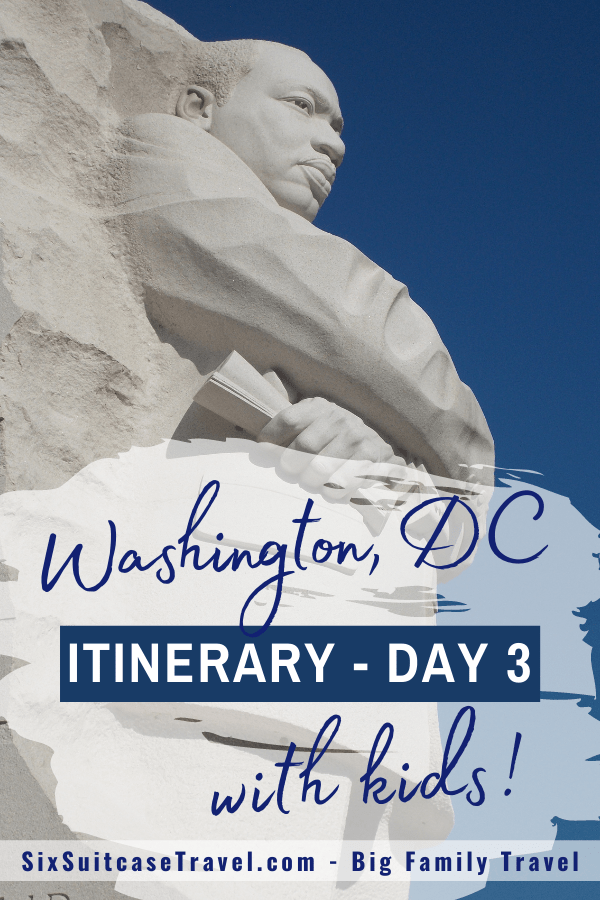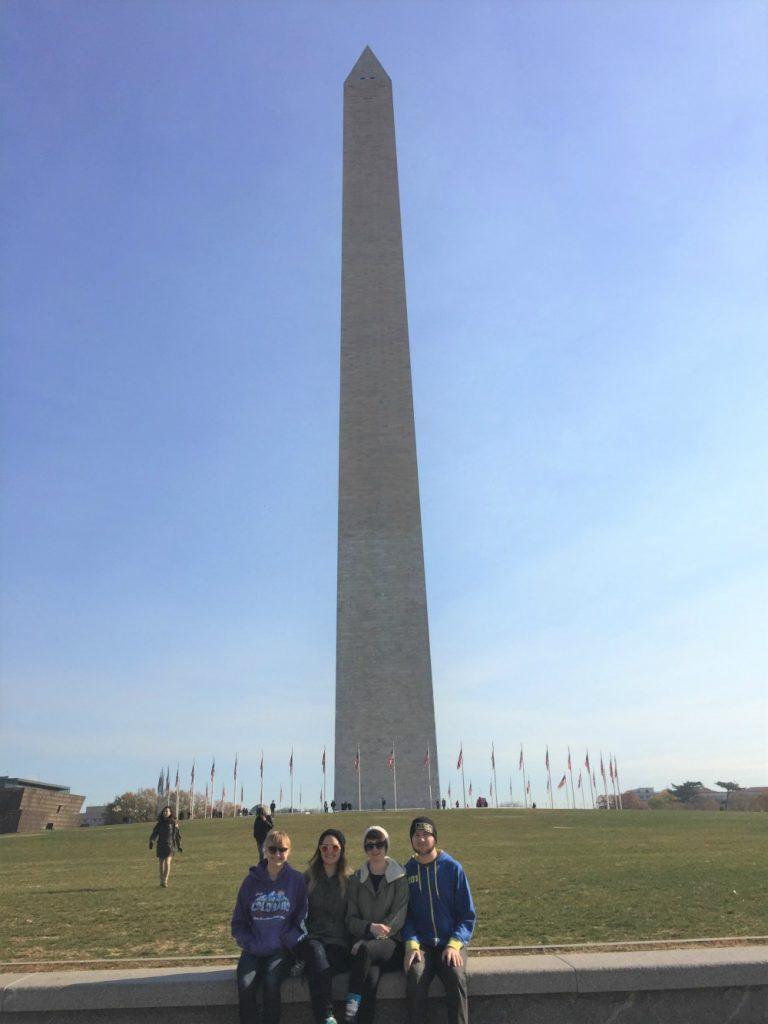Our final day in Washington, D.C., was packed with iconic sights and experiences. From a close-up view of the White House to visiting multiple memorials along the National Mall, and ending with the deeply moving U.S. Holocaust Memorial Museum, this was a day full of history, reflection, and family exploration.
If you’re planning a trip to DC with kids, day three offers a balance of walking and sightseeing with plenty of opportunities to learn about our nation’s history and the people who shaped it. Here’s how our final day unfolded and tips to help make your visit smooth and memorable.

Day Three Suggested Washington, DC Itinerary:
- White House, Washington Monument, and 7 memorials 9:30-1
- Lunch at US Holocaust Museum Cafe
- US Holocaust Museum 1:30-4:30
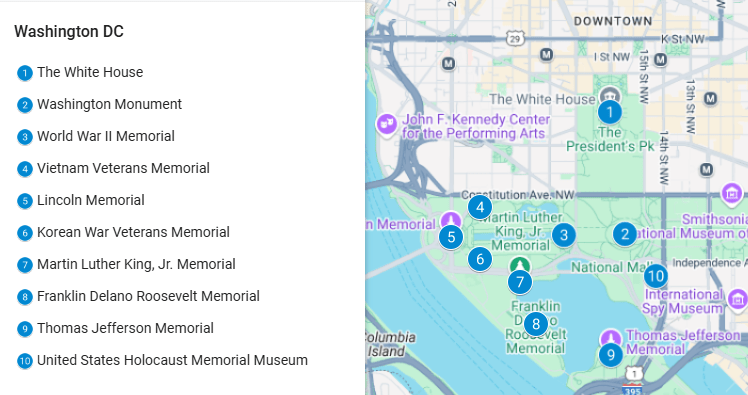
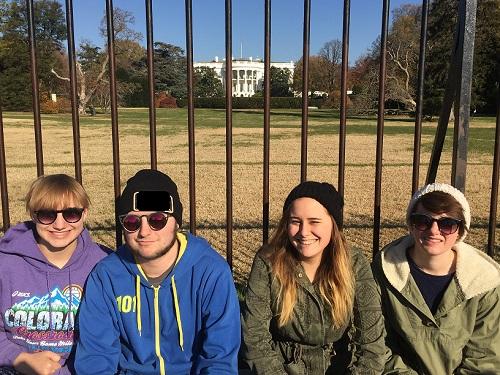
White House
We started our day with an UberXL ride to St. John’s Episcopal Church on H Street NW—a historic location often referred to as the “Church of the Presidents.” From there, we strolled across the street to Lafayette Square, where we spotted statues of General Andrew Jackson and Marquis de Lafayette, offering us a small glimpse into the park’s historical significance.
Reaching the White House, we stopped at the North Lawn fence to take pictures. I was surprised by how close we could get to this iconic building—it was exciting for the entire family to stand just steps away from such an important part of American history. Through the fence, we could see tourists waiting in line for a White House tour.
Though I had applied for the tour about 2.5 months in advance, we weren’t approved. While disappointing initially, I later found out that many reviews describe the tour as brief and underwhelming. If a White House tour is a must for your family, be sure to apply up to six months ahead through your congressional representative for the best chance of approval.
From there, we circled the White House, walking west and getting a good look at the towering and ornate Eisenhower Executive Office Building. Built between 1871 and 1888, this beautiful structure with over 550 rooms houses many White House staff members. We then continued to the South Lawn fence for more Instagram-worthy views, including a great angle of the Washington Monument.
White House Travel Tip:
Apply for a White House tour as early as possible—up to six months ahead of time. Be sure to reach out to your congressional representative for assistance. Even if a tour isn’t part of your itinerary, seeing the White House up close and taking in its surrounding landmarks is a must-visit stop.
Washington Monument: The Centerpiece of the National Mall
From the White House, we began our walk toward the towering Washington Monument, about a mile south. Despite the distance, the walk felt manageable with the 555-foot marble obelisk growing larger as we got closer. It served as a striking focal point, drawing us in and providing incredible views of the city along the way. Standing at the center of the National Mall, the monument offers sweeping perspectives of several iconic landmarks, including the White House, the Capitol Building, the Jefferson Memorial, and the Lincoln Memorial.
One thing that surprised us was just how tall the Washington Monument is—it’s even taller than I had imagined. At 555 feet, it surpasses the height of the Statue of Liberty (305 feet) but is shorter than the Gateway Arch in St. Louis (630 feet).
Unfortunately, we couldn’t go inside since tickets weren’t available during our visit, but the monument is open for guests to ride the elevator to its near-top observation deck when tickets are available. This offers incredible bird’s-eye views of the city and an unforgettable experience, so it’s a worthwhile addition if you can secure tickets in advance.
Washington Monument Travel Tip:
Tickets to tour the Washington Monument are limited. Be sure to check availability and book tickets in advance online to avoid missing out. The National Park Service website provides helpful information on how to secure your spot.
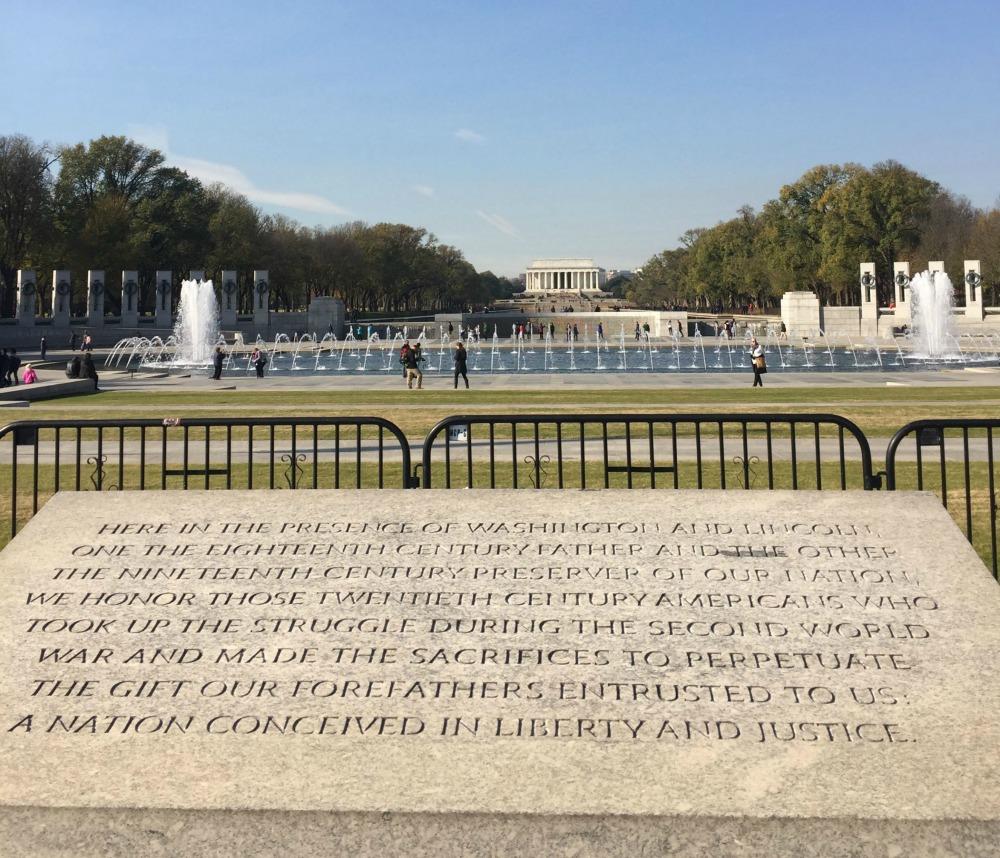
The National Mall is a place of deep historical and emotional significance, featuring powerful monuments and memorials that honor important moments and individuals in American history. Spanning the distance between the Washington Monument and the Lincoln Memorial, each tribute tells a story of courage, sacrifice, and vision. Walking through the memorials is a humbling and reflective experience, offering families an opportunity to learn about and pay their respects to the people and events that have shaped our nation.
- WWII Memorial: This grand memorial honors the 16 million Americans who served during World War II, as well as the over 400,000 who died. Its design features arches, fountains, and a wall of stars representing the lives lost.
- Vietnam Veterans Memorial: Known for its striking black granite wall engraved with over 58,000 names, this memorial pays tribute to the U.S. service members who died or went missing during the Vietnam War.
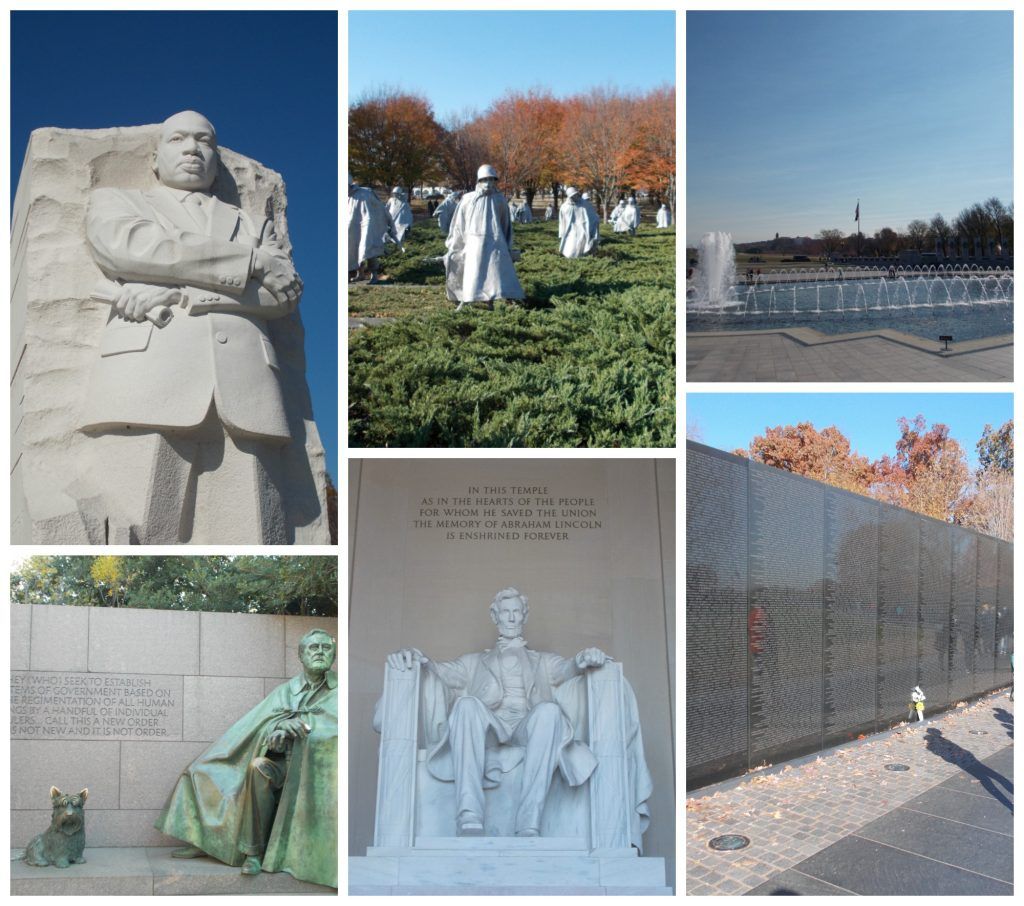
- Lincoln Memorial: A majestic tribute to Abraham Lincoln, the 16th U.S. president, renowned for his leadership during the Civil War and his dedication to ending slavery. The iconic statue of Lincoln sits within a neoclassical temple overlooking the Reflecting Pool.
- Korean War Memorial: This somber memorial features 19 stainless steel statues symbolizing soldiers in action and honors the service and sacrifice of those who fought in the Korean War, often called “The Forgotten War.”
- Martin Luther King Jr. Memorial: A powerful depiction of Dr. King’s legacy, this memorial features a massive sculpture of him emerging from a “Stone of Hope,” inspired by his famous “I Have a Dream” speech.
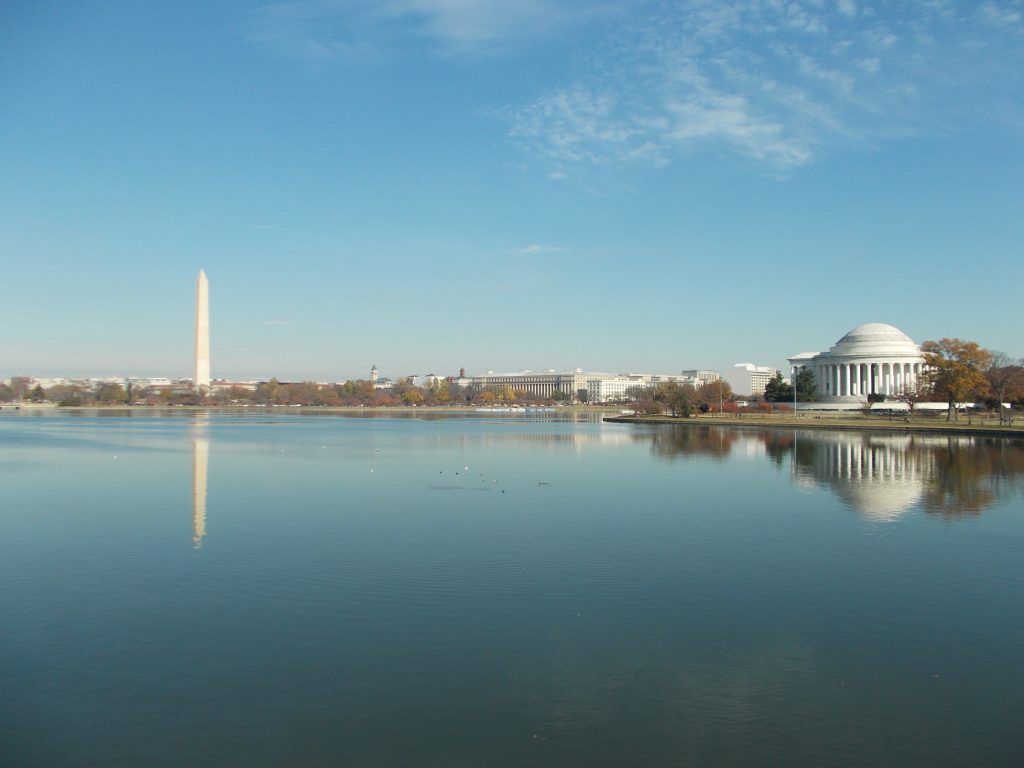
After finishing our visit to the Lincoln Memorial and surrounding landmarks, we walked around the beautiful Tidal Basin to reach the Jefferson Memorial. The path was scenic and peaceful, offering stunning waterfront views along the way. This neoclassical memorial honors Thomas Jefferson, the third U.S. president, and author of the Declaration of Independence. Standing inside, we admired the towering bronze statue of Jefferson, surrounded by four inspiring quotes engraved on the walls, each reflecting his vision of liberty, democracy, and human rights.
- Franklin D. Roosevelt Memorial: Spanning over seven acres, this expansive memorial reflects FDR’s four terms as president, showcasing statues, quotes, and waterfalls to illustrate the challenges of the Great Depression and World War II.
- Jefferson Memorial: A neoclassical masterpiece dedicated to Thomas Jefferson, this memorial celebrates the third U.S. president’s contributions to freedom and democracy, including being the primary author of the Declaration of Independence.
National Mall Travel Tips:
- Take your time going through the memorials, show respect. Better yet, learn about each memorial before your trip – who the memorials honor and when built.
- Good to know – map of public restrooms on the Mall.
From there, we continued our walk along the Tidal Basin, soaking in the serene atmosphere before heading up Raoul Wallenberg Place to the U.S. Holocaust Memorial Museum.
By the time we arrived at the museum, we were ready for lunch, so we stopped at the museum’s cafe. The cafe offered a casual, family-friendly selection of vegetarian-friendly options. The kids happily chose personal cheese pizzas, while I opted for a satisfying bean and cheese quesadilla. With lunch wrapped up, we were ready to dive into the next powerful and educational experience of our trip.
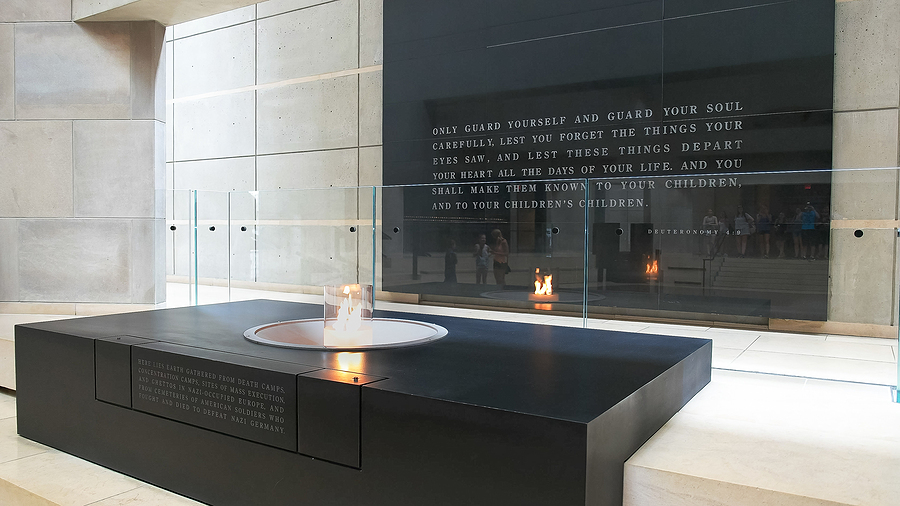
US Holocaust Memorial Museum: A Powerful and Unforgettable Experience
The U.S. Holocaust Memorial Museum is a deeply moving and thought-provoking space that demands both reflection and respect. For our family, this visit was an essential part of our DC itinerary, offering an unparalleled opportunity to learn about one of history’s darkest chapters through powerful exhibits and storytelling.
We began on the museum’s fourth floor, which explores the events from 1933-1939, including Hitler’s rise to power, the escalating antisemitic policies, and the early stages of persecution. I was struck by the clarity and detail with which the museum explained how entire nations could be swept into hatred and complicity, something often glossed over in school lessons. Particular exhibits illuminated how desperate Jewish refugees faced widespread rejection from countries around the world—a sobering reminder of the consequences of indifference.
The third floor covers the years 1940-1945, delving further into the horrors of the Holocaust and the implementation of the Final Solution. This portion of the museum was both heart-wrenching and eye-opening. Walking through the exhibits, you feel the weight of the personal stories shared among photographs, artifacts, and survivor testimonies. The displays were designed thoughtfully—with some of the most graphic material placed behind walls, ensuring visitors can choose what they are ready to encounter.
We spent about three hours exploring the museum’s main exhibitions, and as a family, we had important conversations about what we’d seen and its relevance to understanding humanity, justice, and tolerance today. Each of us left with a profound sense of remembrance and responsibility to reflect on the lessons learned here.
Holocaust Museum Travel Tip:
Plan ample time for your visit; there is a lot to read and absorb throughout the exhibitions. For families with younger children, be aware of sensitive content. Exhibits with graphic materials are strategically placed to offer some discretion for young guests.
.
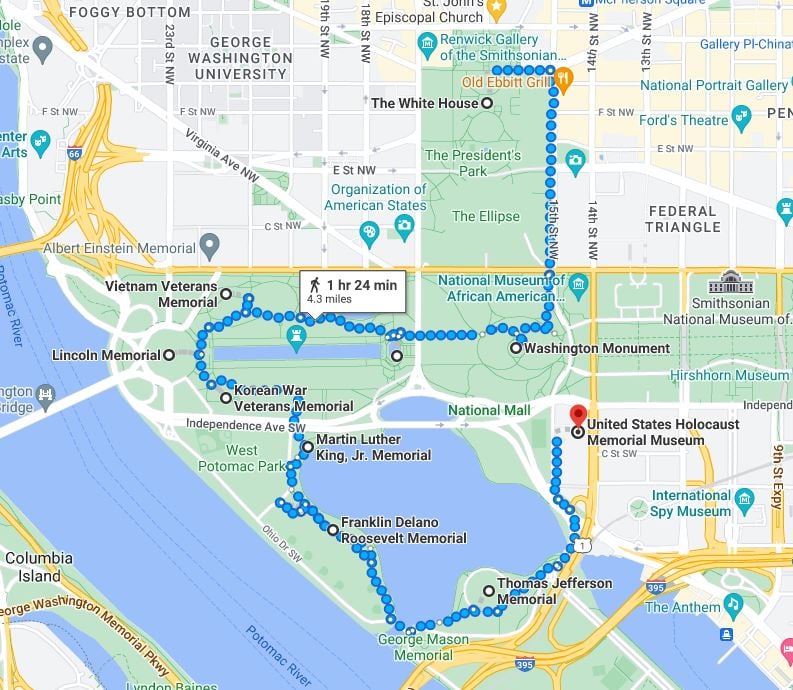
Our three-day family adventure in Washington, D.C., was a perfect blend of education, history, and unforgettable moments. From iconic landmarks like the White House and the Washington Monument to reflective visits at the powerful memorials and the U.S. Holocaust Memorial Museum, the trip offered an incredible way to connect with our nation’s past.
Visiting D.C. truly brings school history lessons to life, giving both kids and adults a chance to see the stories they’ve read about in textbooks come alive. And for any Forrest Gump fans, you’ll love spotting locations from the movie, like the Reflecting Pool and the Lincoln Memorial.
Whether you’re traveling with kids, teens, or extended family, Washington, D.C., provides a rich and meaningful experience everyone should have at least once.
